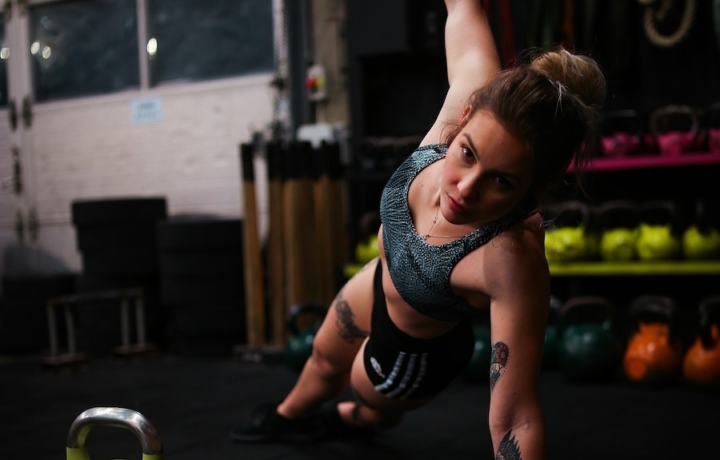Exercise
Weighted Decline Crunch

Weighted Decline Crunch
How to Perform
- Position yourself on a decline bench with your feet securely anchored under the foot pads and hold a weight plate against your chest.
- Lie back on the bench so your head is lower than your hips, keeping your lower back pressed against the bench pad.
- Engage your core muscles and hold the weight firmly against your upper chest or across your shoulders.
- Inhale as you prepare for the movement, maintaining a neutral neck position with your gaze toward the ceiling.
- Exhale as you contract your abdominals to curl your torso upward, bringing your shoulders and upper back off the bench.
- Lift only until your shoulder blades clear the bench, focusing on using your abdominal muscles rather than your hip flexors.
- Hold the contracted position briefly at the top while maintaining tension in your core.
- Inhale as you slowly lower your upper body back to the starting position in a controlled manner, maintaining tension in your abdominals throughout the descent.
Important information
- Keep the weight stable throughout the movement; don't allow it to drift away from your chest as you curl up.
- Focus on curling your ribcage toward your pelvis rather than just lifting your head and shoulders.
- Avoid pulling on your neck or jerking your body to complete the movement; the power should come from your abdominals.
- If you experience lower back discomfort, reduce the decline angle or switch to a flat bench variation.

Weighted Decline Crunch
Exercise Details
Primary Muscles
Muscle Groups
Mechanic
Built for progress
Take the guesswork out of training
Create personalized AI-powered workout plans that evolve with you. Train smarter, track every rep and keep moving forward, one workout at a time.






The Weighted Decline Crunch stands as a powerful advancement in core training, taking the traditional crunch to new intensity levels for those ready to push beyond beginner ab workouts. This intermediate exercise specifically targets the abdominal muscles, with primary emphasis on the rectus abdominis (your "six-pack" muscles) while engaging the entire core stabilization system.
For serious bodybuilders and HIIT enthusiasts alike, this variation delivers exceptional muscle activation by combining the mechanical advantage of a declined position with added resistance. The decline bench position creates a greater range of motion against gravity, while the additional weight challenges your abs to generate more force, stimulating greater muscle fiber recruitment and potential hypertrophy in your midsection.
Strength development in the core goes far beyond aesthetic benefits. A robust midsection serves as the foundation for power transfer throughout the body, potentially improving performance across all major lifts from squats to overhead presses. The weighted component specifically helps build functional strength that translates to everyday activities and athletic movements requiring trunk stability under load.
The beauty of this exercise lies in its versatility within your training regimen. Bodybuilders might implement it during specific ab-focused days with moderate weight and higher repetitions to sculpt definition, while those following HIIT protocols could incorporate it as a strength station with challenging weight for maximum core engagement during intense circuits.
As with any weighted exercise, progression is key to continued results. Your abs respond to progressive overload just like any other muscle group, making this an excellent option for intermediate fitness enthusiasts looking to advance their core training. The combination of the decline position and added resistance creates the perfect stimulus for abdominal development when you've outgrown basic variations but aren't quite ready for advanced gymnastic-style core movements.
FAQ - Weighted Decline Crunch
The Weighted Decline Crunch primarily targets the rectus abdominis (six-pack muscles), with secondary engagement of the obliques and deeper core stabilizers. The decline position increases activation in the upper portion of the abs compared to flat crunches.
Beginners should start with bodyweight-only decline crunches to master proper form before adding external resistance. Once ready, begin with a light weight (5-10 pounds) held at your chest, and gradually increase as your core strength improves.
Place your hands with the weight across your chest rather than behind your head, keep your chin slightly tucked throughout the movement, and focus on lifting with your abdominals rather than pulling with your neck muscles. If you experience neck pain, reduce the weight immediately.
Include this exercise 2-3 times weekly with at least 48 hours between sessions to allow for adequate muscle recovery. Treat your abs like any other muscle group—they need time to repair and grow stronger after intense training.
For strength development, perform 3-4 sets of 8-12 reps with challenging weight. For endurance and definition, use lighter weight for 12-20 reps per set. Progressive overload is crucial, so gradually increase weight or reps as your core strength improves.







